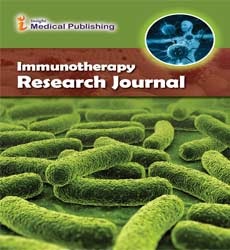Immuno-Therapy Research
1Primary Emeritus of the Hospital Company "D. Cotugno ", Naples, Italy
2Virosphere Biotechnology Committee, WABT - UNESCO, Paris
3University of Thomas More U.P.T.M., Rome, Italy
4Beaumont Bonelli Foundation for Cancer Research – ONLUS, Italy
- *Corresponding Author:
- Giulio Tarro
Primary Emeritus of the Hospital Company "D. Cotugno"
Naples, Italy
Tel: +393393546347
E-mail: giuliotarro@gmail.com
Received date: July 28, 2017; Accepted date: July 29, 2017; Published date: August 07, 2017
Citation: Tarro G (2017) Immuno-Therapy Research. Immunother Res. Vol. 1 No. 1:2
Despite multimodality treatment strategies including surgery, radiotherapy, chemotherapy and targeted therapy, lung cancer is still the first leading cause of cancer related death in the world with the 5 year lung cancer survival rate remaining as low as 15%. The most common histologies are summarized as nonsmall- cell lung cancer (NSCLC) and account for 80-85% of newly diagnosed cases. Surgery remains the best curative option and standard of care for functionally operable early-stage NSCLC and resectable stage IIIA disease. However, only 20% of NSCLC are resectable at diagnosis. Therefore, early detection approaches – especially in the population at high risk for the development of this disease – remains an unmet clinical need. Previous studies have investigated the potential role of blood-based tumor markers for early detection, diagnosis, prognostication, postoperative follow-up as well as monitoring of tumor burden and response to treatment in advanced disease stages. To date, the most commonly used markers include neuron specific enolase (NSE), carcinoembryonic antigen (CEA), cytokeratin 19 fragments (CYFRA 21-1) and cancer antigen CA 125 (CA 125). However, low sensitivity, specificity or reproducibility limit their clinical utility in the care of patients with lung cancer and no single marker has gained widespread acceptance as diagnostic test, prognostic indicator or monitor of treatment response. Ideally, a tumor marker should have a sensitivity and specificity of 100%, a goal that is almost never achieved. One strategy potentially increasing both parameters is to combine several markers into a marker panel. Combined with other noninvasive methods, this may allow for much needed further refinement of lung cancer screening and monitoring. 2 In 1983, a tumor-associated antigen was isolated from NSCLC and named tumor liberated protein (TLP) by Tarro et al. [1]. The immunohistochemical analysis revealed a cytoplasmic localization of TLP in small and larger granules. In some specimens it was also detected in the lumen of atypical glands and in the bronchial secretions, suggesting that TLP could be considered a secretory product of neoplastic cells. Tarro et al. [2] have demonstrated that when TLP is extracted from a patient’s tumor, purified in the laboratory and reintroduced into the body, it boosts an immune response in the host. The partial sequence analysis of this protein led to the synthesis of corresponding antigenic peptides that have been used to produce antisera in rabbits. According to Tarro et al. [3], four TLP-derived peptides were identified: RTNKEASI, GSAXFTN, QRNRD and GPPEVQNAN. Anti-RTNKEASI rabbit sera reacted specifically with NSCLC tumor extracts as well as sera from lung cancer patients [4]. TLP was detected in sera of 53.1% of NSCLC patients (N = 534) with 75% being positive in the early stage (stage I) dropping to 45% in the late stage (stage IV), suggesting a potential role as early screening biomarker [5]. ALDHs are a large family of intracellular enzymes that participate in cellular detoxification, differentiation and drug resistance through the oxidation of endogenous and exogenous aldehydes to carboxylic acids. The ALDH superfamily currently consists of 19 known putatively functional genes in 11 families and 4 subfamilies with distinct chromosomal locations. The different family members exhibit heterogeneous tissue distribution and have been localized predominantly in the cytosol and mitochondria. Several studies have explored the biological significance of ALDH in cancers such as head and neck, colon cancer, breast cancer, papillary thyroid carcinoma and specifically in lung cancer, where they have provided supportive evidence for the association 3 between ALDH activity and lung cancer stem cells. Recently, serum levels of ALDH1A1 were shown to be elevated in the sera of patients with NSCLC. Combined testing of serum ALDH1A1 and CEA levels significantly increased the screening sensitivity of CEA alone [6].
Conflict of Interest
None.
References
- Tarro G, Pederzini A, Flaminio G, Maturo S (1983) Human tumor antigens inducing in vivo delayed hypersensitivity and in vitro mitogenic activity. Oncology 40: 248-254.
- Tarro G, Perna A, Esposito C (2005) Early diagnosis of lung cancer by detection of tumor liberated protein. J Cell Physiol 203: 1-5.
- Tarro G (2009) Tumor liberated protein from lung cancer and perspectives for immunotherapy. J Cell Physiol 221: 26-30.
- Tarro G, Marshak DR, Perna A, Esposito C (1993) Antigenic regions of tumor liberated protein complexes and antibodies against the same. Biomed Pharmacother 47: 237-240.
- Guadagni F, Graziano P, Roselli M, Mariotti S, Bernard P, et al. (1999) Differential expression of a new tumor-associated-antigen TLP during human colorectal cancer tumorigenesis. Am J Pathol 154: 993-999.
- Tarro G (2017) From sequence of tumor liberated protein (TLP) to potential targets for diagnosis and therapy. Integr Mol Med 4: 1-3.
Open Access Journals
- Aquaculture & Veterinary Science
- Chemistry & Chemical Sciences
- Clinical Sciences
- Engineering
- General Science
- Genetics & Molecular Biology
- Health Care & Nursing
- Immunology & Microbiology
- Materials Science
- Mathematics & Physics
- Medical Sciences
- Neurology & Psychiatry
- Oncology & Cancer Science
- Pharmaceutical Sciences
